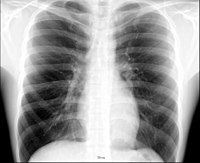
Photo from wikipedia
OBJECTIVES To investigate the effect of wearing hardhatson the lower cervical and upper thoracic region using surface electromyography (sEMG) and possible link to Work Related Musculoskeletal Disorder (WRMSD). METHODS Twenty… Click to show full abstract
OBJECTIVES To investigate the effect of wearing hardhatson the lower cervical and upper thoracic region using surface electromyography (sEMG) and possible link to Work Related Musculoskeletal Disorder (WRMSD). METHODS Twenty study subjects wore sEMG sensors placed on the upper trapezius muscle on their dominant side to assess muscle activity while wearing different hardhats. Study subjects were asked to donsix different hard hats and assume varied neck postures. A repeated-measures design was used to analyze the results for difference and similarities in muscle activity. RESULTS There was a small, significant effect of wearing a hardhat on muscle loading in the upper trapezius (p = 0.038). Post-hoc analyses revealed the only statistically significant difference was between wearing no hard hat at all and wearing head protection (without accessories) in the flexed posture (p = 0.006). CONCLUSION The results demonstrated that there was little difference in lower cervical and upper thoracic muscle activity while donning hardhat and assuming various neck postures. Wearing a sample of commonly used hardhats in this study does not appear to substantially increase muscle activity that would cause fatigue in the lower cervical and upper thoracic region among young, healthy volunteer subjects.
Journal Title: Work
Year Published: 2020
Link to full text (if available)
Share on Social Media: Sign Up to like & get
recommendations!